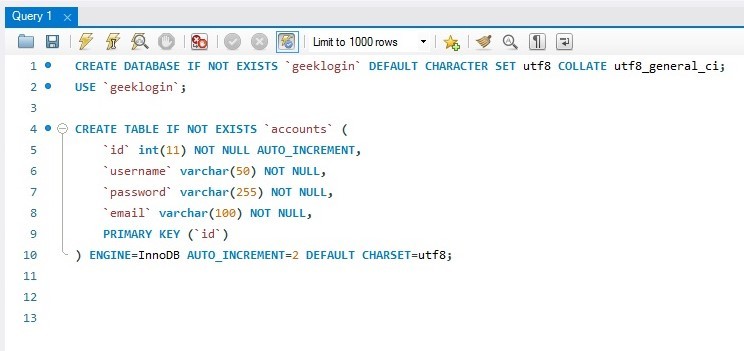

- #Creating mysql database workbench and using with flask how to#
- #Creating mysql database workbench and using with flask install#
- #Creating mysql database workbench and using with flask driver#
- #Creating mysql database workbench and using with flask code#
To effectively use MySql or PostgreSQL in our application, we need to have a few things already installed on workstation:
#Creating mysql database workbench and using with flask code#
Using SQLite in our development is great and we can code quite fast all application features and logic without limitations but in production where we might have high traffic probably is better for our project and our users to migrate the database layer to MySql or PostgreSQL. > user1 = User(username='user1', # Add the new user to the SqlAlchemy session Once the table is created, we can add content using the console > # get User object into the context To table can be created with ease via Flask CLI: $ # Open the Flask shell This sample (copied from the official docs) define a `User` table, create a Flask app and bind the SQLAlchemy library to our app. Username = db.Column(db.String(80), unique=True, nullable=False)Įmail = db.Column(db.String(120), unique=True, nullable=False) Id = db.Column(db.Integer, primary_key=True) Create the SQLAlchemy object and bind it to the Flask objectĪpp.config = 'sqlite:////tmp/test.db'.Define 'SQLALCHEMY_DATABASE_URI' in configuration.A simple app that uses SQLAlchemy should perform three things:

Using Flask-SQLAlchemy into a new Flask application should be easy if we spent a few minutes to take a look at the official documentation.
#Creating mysql database workbench and using with flask install#
$ pip install -U Flask-SQLAlchemy Flask-SQLAlchemy Is quite important to know that Flask access SQLAlchemy features via a Flask-SQLAlchemy Extension, the "glue" between our application and SQLAlchemy core. This toolkit can be used with Python2 and Python3 and covers all popular SQL dialects and engines: SQLite, Postgresql, MySQL, Oracle, MS-SQL, Firebird and others. SQLAlchemy is the Python SQL toolkit and Object Relational Mapper (ORM) that provides a clean, object oriented access the information saved in the database. This sample code will display classic "Hello World" in the browser. Once the installation is complete, we can code a new, minimal app by saving and executing the code: from flask import Flask It provides the flask command and allows adding custom management commands.
#Creating mysql database workbench and using with flask driver#
MySql set up - install server and Python driver.
#Creating mysql database workbench and using with flask how to#
SQLAlchemy - how to access information with ease.Sometimes classified as a microframework, Flask provides a lightweight codebase that can be easily extended to become an API, a simple web app, or a complex eCommerce platform. For newcomers, Flask is a lightweight web application framework written in Python. This article explains how to connect a MySQL or SQLite database to a Flask-based project using SQLAlchemy, a popular Python SQL toolkit that empowers a clean, object oriented access to the database.


 0 kommentar(er)
0 kommentar(er)
